open bonnet Peugeot 508 2019 Owner's Manual
[x] Cancel search | Manufacturer: PEUGEOT, Model Year: 2019, Model line: 508, Model: Peugeot 508 2019Pages: 320, PDF Size: 10.09 MB
Page 26 of 320
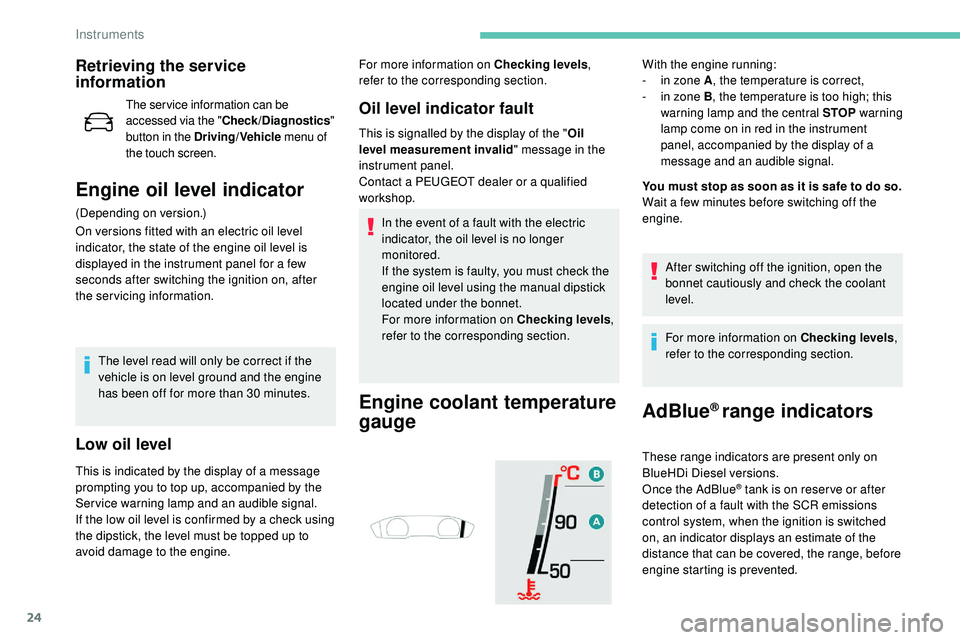
24
Retrieving the service
information
The ser vice information can be
accessed via the "Check/Diagnostics "
button in the Driving/Vehicle menu of
the touch screen.
Engine oil level indicator
(Depending on version.)
On versions fitted with an electric oil level
indicator, the state of the engine oil level is
displayed in the instrument panel for a few
seconds after switching the ignition on, after
the servicing information.
The level read will only be correct if the
vehicle is on level ground and the engine
has been off for more than 30 minutes.
Low oil level
This is indicated by the display of a message
prompting you to top up, accompanied by the
Service warning lamp and an audible signal.
If the low oil level is confirmed by a check using
the dipstick, the level must be topped up to
avoid damage to the engine. For more information on Checking levels
,
refer to the corresponding section.
Oil level indicator fault
This is signalled by the display of the " Oil
level measurement invalid " message in the
instrument panel.
Contact a PEUGEOT dealer or a qualified
workshop.
In the event of a fault with the electric
indicator, the oil level is no longer
monitored.
If the system is faulty, you must check the
engine oil level using the manual dipstick
located under the bonnet.
For more information on Checking levels ,
refer to the corresponding section.
Engine coolant temperature
gauge
With the engine running:
- i n zone A , the temperature is correct,
-
i
n zone B , the temperature is too high; this
warning lamp and the central STOP warning
lamp come on in red in the instrument
panel, accompanied by the display of a
message and an audible signal.
You must stop as soon as it is safe to do so.
Wait a few minutes before switching off the
engine.
After switching off the ignition, open the
bonnet cautiously and check the coolant
level.
For more information on Checking levels ,
refer to the corresponding section.
AdBlue® range indicators
These range indicators are present only on
BlueHDi Diesel versions.
Once the AdBlue
® tank is on reser ve or after
detection of a fault with the SCR emissions
control system, when the ignition is switched
on, an indicator displays an estimate of the
distance that can be covered, the range, before
engine starting is prevented.
Instruments
Page 46 of 320
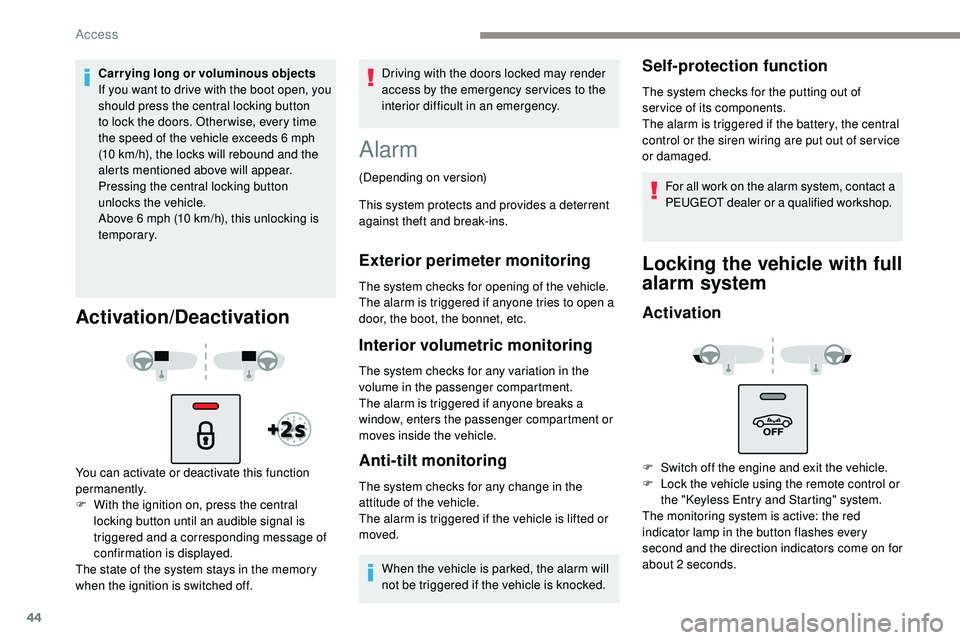
44
Carrying long or voluminous objects
If you want to drive with the boot open, you
should press the central locking button
to lock the doors. Other wise, every time
the speed of the vehicle exceeds 6 mph
(10 km/h), the locks will rebound and the
alerts mentioned above will appear.
Pressing the central locking button
unlocks the vehicle.
Above 6 mph (10 km/h), this unlocking is
te m p o r a r y.
Activation/Deactivation
You can activate or deactivate this function
permanently.
F
W
ith the ignition on, press the central
locking button until an audible signal is
triggered and a corresponding message of
confirmation is displayed.
The state of the system stays in the memory
when the ignition is switched off. Driving with the doors locked may render
access by the emergency services to the
interior difficult in an emergency.
Alarm
(Depending on version)
This system protects and provides a deterrent
against theft and break-ins.
Exterior perimeter monitoring
The system checks for opening of the vehicle.
The alarm is triggered if anyone tries to open a
door, the boot, the bonnet, etc.
Interior volumetric monitoring
The system checks for any variation in the
volume in the passenger compartment.
The alarm is triggered if anyone breaks a
window, enters the passenger compartment or
moves inside the vehicle.
Anti-tilt monitoring
The system checks for any change in the
attitude of the vehicle.
The alarm is triggered if the vehicle is lifted or
moved.
When the vehicle is parked, the alarm will
not be triggered if the vehicle is knocked.
Self-protection function
The system checks for the putting out of
ser vice of its components.
The alarm is triggered if the battery, the central
control or the siren wiring are put out of ser vice
or damaged.For all work on the alarm system, contact a
PEUGEOT dealer or a qualified workshop.
Locking the vehicle with full
alarm system
Activation
F Switch off the engine and exit the vehicle.
F L ock the vehicle using the remote control or
the "Keyless Entry and Starting" system.
The monitoring system is active: the red
indicator lamp in the button flashes every
second and the direction indicators come on for
about 2 seconds.
Access
Page 47 of 320
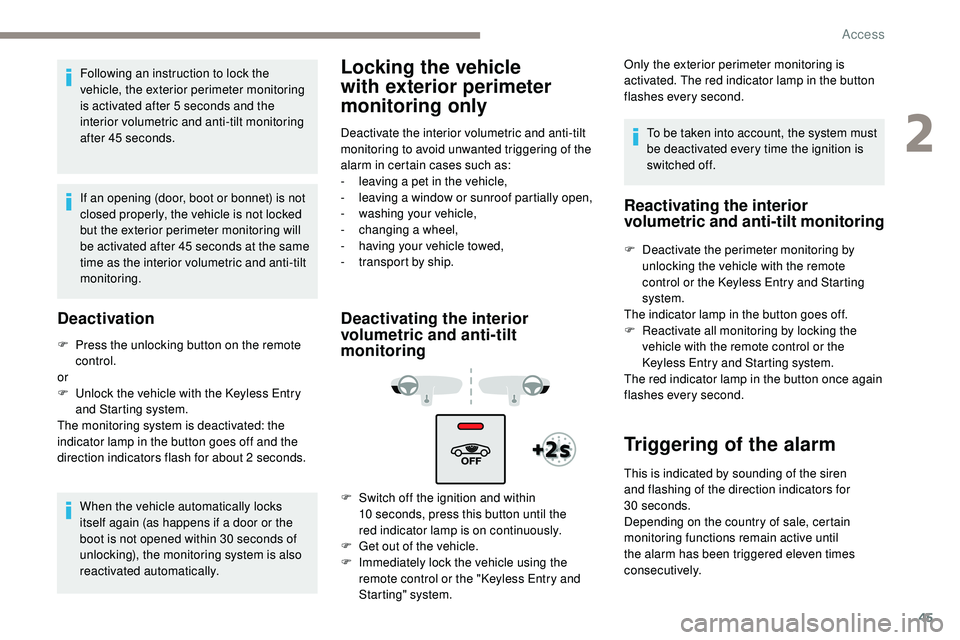
45
Following an instruction to lock the
vehicle, the exterior perimeter monitoring
is activated after 5 seconds and the
interior volumetric and anti-tilt monitoring
after 45 seconds.
If an opening (door, boot or bonnet) is not
closed properly, the vehicle is not locked
but the exterior perimeter monitoring will
be activated after 45 seconds at the same
time as the interior volumetric and anti-tilt
monitoring.
Deactivation
F Press the unlocking button on the remote control.
or
F
U
nlock the vehicle with the Keyless Entry
and Starting system.
The monitoring system is deactivated: the
indicator lamp in the button goes off and the
direction indicators flash for about 2 seconds.
When the vehicle automatically locks
itself again (as happens if a door or the
boot is not opened within 30 seconds of
unlocking), the monitoring system is also
reactivated automatically.
Locking the vehicle
with exterior perimeter
monitoring only
Deactivate the interior volumetric and anti-tilt
monitoring to avoid unwanted triggering of the
alarm in certain cases such as:
-
l
eaving a pet in the vehicle,
-
l
eaving a window or sunroof partially open,
-
w
ashing your vehicle,
-
c
hanging a wheel,
-
h
aving your vehicle towed,
-
t
ransport by ship.
Deactivating the interior
volumetric and anti-tilt
monitoring
F Switch off the ignition and within 10 seconds, press this button until the
red
indicator lamp is on continuously.
F
G
et out of the vehicle.
F
I
mmediately lock the vehicle using the
remote control or the "Keyless Entry and
Starting" system. To be taken into account, the system must
be deactivated every time the ignition is
switched off.
Reactivating the interior
volumetric and anti-tilt monitoring
F Deactivate the perimeter monitoring by
unlocking the vehicle with the remote
control or the Keyless Entry and Starting
system.
The indicator lamp in the button goes off.
F
R
eactivate all monitoring by locking the
vehicle with the remote control or the
Keyless Entry and Starting system.
The red indicator lamp in the button once again
flashes every second.
Triggering of the alarm
Only the exterior perimeter monitoring is
activated. The red indicator lamp in the button
flashes every second.
This is indicated by sounding of the siren
and flashing of the direction indicators for
30
seconds.
Depending on the country of sale, certain
monitoring functions remain active until
the alarm has been triggered eleven times
consecutively.
2
Access
Page 111 of 320
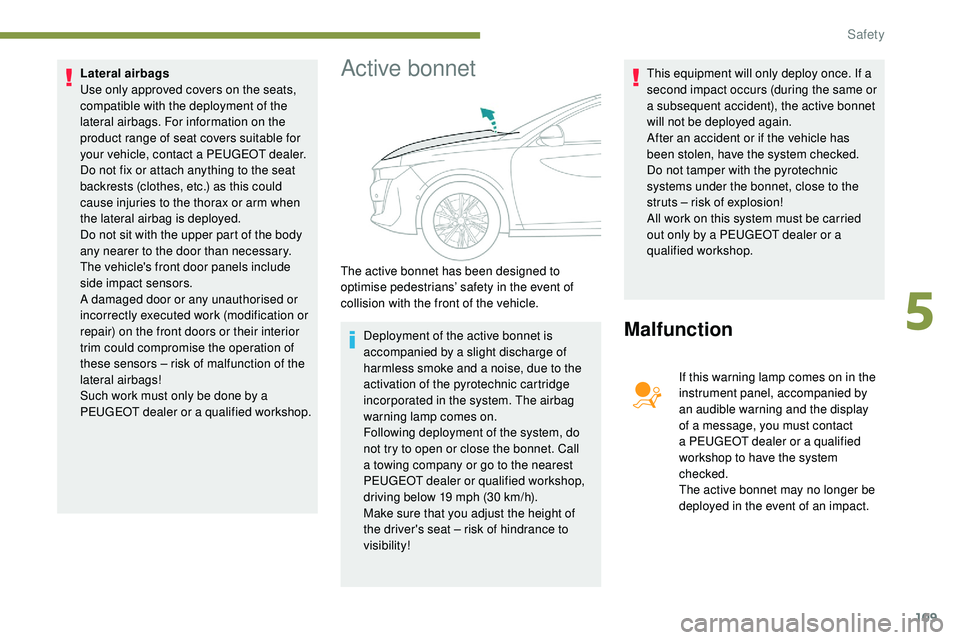
109
Lateral airbags
Use only approved covers on the seats,
compatible with the deployment of the
lateral airbags. For information on the
product range of seat covers suitable for
your vehicle, contact a PEUGEOT dealer.
Do not fix or attach anything to the seat
backrests (clothes, etc.) as this could
cause injuries to the thorax or arm when
the lateral airbag is deployed.
Do not sit with the upper part of the body
any nearer to the door than necessary.
The vehicle's front door panels include
side impact sensors.
A damaged door or any unauthorised or
incorrectly executed work (modification or
repair) on the front doors or their interior
trim could compromise the operation of
these sensors – risk of malfunction of the
lateral airbags!
Such work must only be done by a
PEUGEOT dealer or a qualified workshop.Active bonnet
Deployment of the active bonnet is
accompanied by a slight discharge of
harmless smoke and a noise, due to the
activation of the pyrotechnic cartridge
incorporated in the system. The airbag
warning lamp comes on.
Following deployment of the system, do
not try to open or close the bonnet. Call
a towing company or go to the nearest
PEUGEOT dealer or qualified workshop,
driving below 19 mph (30 km/h).
Make sure that you adjust the height of
the driver's seat – risk of hindrance to
visibility! This equipment will only deploy once. If a
second impact occurs (during the same or
a subsequent accident), the active bonnet
will not be deployed again.
After an accident or if the vehicle has
been stolen, have the system checked.
Do not tamper with the pyrotechnic
systems under the bonnet, close to the
struts – risk of explosion!
All work on this system must be carried
out only by a PEUGEOT dealer or a
qualified workshop.Malfunction
If this warning lamp comes on in the
instrument panel, accompanied by
an audible warning and the display
of a message, you must contact
a PEUGEOT dealer or a qualified
workshop to have the system
checked.
The active bonnet may no longer be
deployed in the event of an impact.
The active bonnet has been designed to
optimise pedestrians’ safety in the event of
collision with the front of the vehicle.
5
Safety
Page 142 of 320
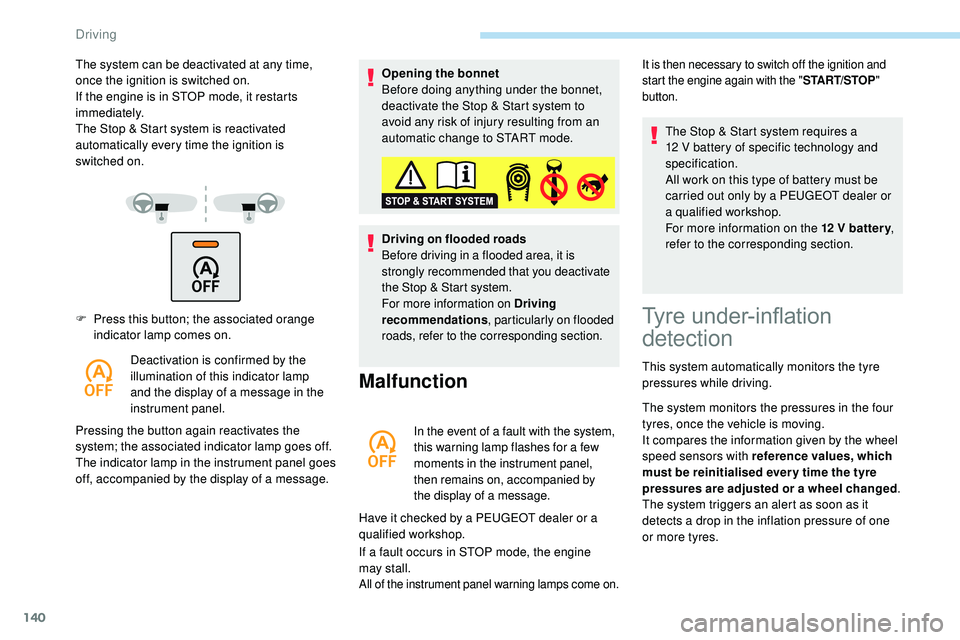
140
F Press this button; the associated orange indicator lamp comes on.
Deactivation is confirmed by the
illumination of this indicator lamp
and the display of a message in the
instrument panel.
Pressing the button again reactivates the
system; the associated indicator lamp goes off.
The indicator lamp in the instrument panel goes
off, accompanied by the display of a message. Opening the bonnet
Before doing anything under the bonnet,
deactivate the Stop & Start system to
avoid any risk of injury resulting from an
automatic change to START mode.
Driving on flooded roads
Before driving in a flooded area, it is
strongly recommended that you deactivate
the Stop & Start system.
For more information on Driving
recommendations
, particularly on flooded
roads, refer to the corresponding section.
Malfunction
In the event of a fault with the system,
this warning lamp flashes for a few
moments in the instrument panel,
then remains on, accompanied by
the display of a message.
Have it checked by a PEUGEOT dealer or a
qualified workshop.
If a fault occurs in STOP mode, the engine
may
stall.
All of the instrument panel warning lamps come on.
The system can be deactivated at any time,
once the ignition is switched on.
If the engine is in STOP mode, it restarts
immediately.
The Stop & Start system is reactivated
automatically every time the ignition is
switched
on.It is then necessary to switch off the ignition and
start the engine again with the " START/STOP"
button.
Tyre under-inflation
detection
This system automatically monitors the tyre
pressures while driving.
The system monitors the pressures in the four
tyres, once the vehicle is moving.
It compares the information given by the wheel
speed sensors with reference values, which
must be reinitialised ever y time the tyre
pressures are adjusted or a wheel changed .
The system triggers an alert as soon as it
detects a drop in the inflation pressure of one
or more tyres. The Stop & Start system requires a
12
V battery of specific technology and
specification.
All work on this type of battery must be
carried out only by a PEUGEOT dealer or
a qualified workshop.
For more information on the 12 V batter y
,
refer to the corresponding section.
Driving
Page 206 of 320
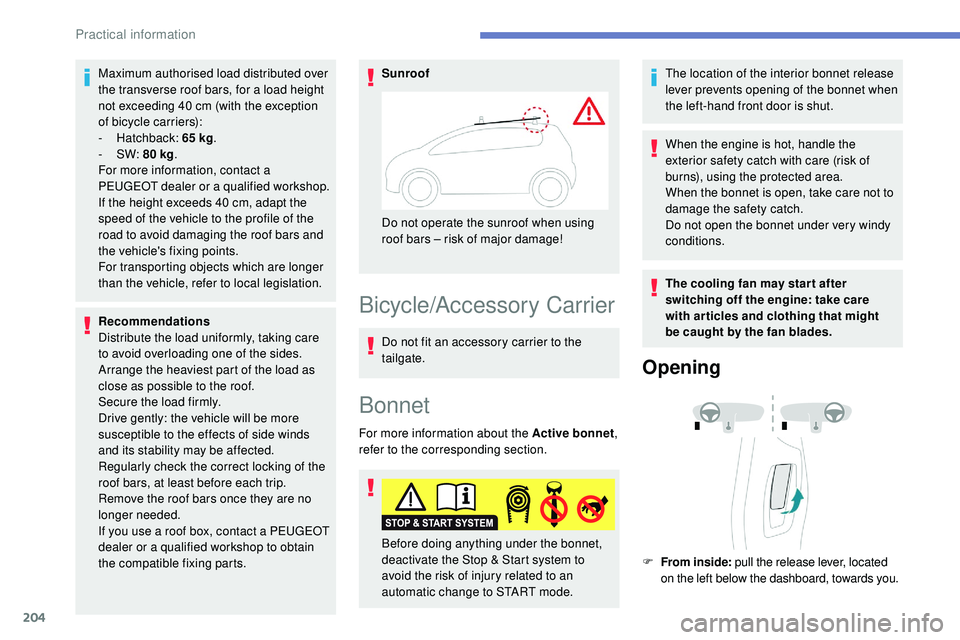
204
Maximum authorised load distributed over
the transverse roof bars, for a load height
not exceeding 40 cm (with the exception
of
bicycle carriers):
-
Hatchback: 65 kg.
-
SW: 80 kg .
For more information, contact a
PEUGEOT dealer or a qualified workshop.
If the height exceeds 40
cm, adapt the
speed of the vehicle to the profile of the
road to avoid damaging the roof bars and
the vehicle's fixing points.
For transporting objects which are longer
than the vehicle, refer to local legislation.
Recommendations
Distribute the load uniformly, taking care
to avoid overloading one of the sides.
Arrange the heaviest part of the load as
close as possible to the roof.
Secure the load firmly.
Drive gently: the vehicle will be more
susceptible to the effects of side winds
and its stability may be affected.
Regularly check the correct locking of the
roof bars, at least before each trip.
Remove the roof bars once they are no
longer needed.
If you use a roof box, contact a PEUGEOT
dealer or a qualified workshop to obtain
the compatible fixing parts. Sunroof
Do not operate the sunroof when using
roof bars – risk of major damage!
Bicycle/Accessory Carrier
Do not fit an accessory carrier to the
tailgate.
Bonnet
For more information about the Active bonnet ,
refer to the corresponding section. The location of the interior bonnet release
lever prevents opening of the bonnet when
the left-hand front door is shut.
When the engine is hot, handle the
exterior safety catch with care (risk of
burns), using the protected area.
When the bonnet is open, take care not to
damage the safety catch.
Do not open the bonnet under very windy
conditions.
The cooling fan may star t after
switching off the engine: take care
with articles and clothing that might
be
caught by the fan blades.
Opening
F From inside:
pull the release lever, located
on the left below the dashboard, towards you.
Before doing anything under the bonnet,
deactivate the Stop & Start system to
avoid
the risk of injury related to an
automatic change to START mode.
Practical information
Page 207 of 320
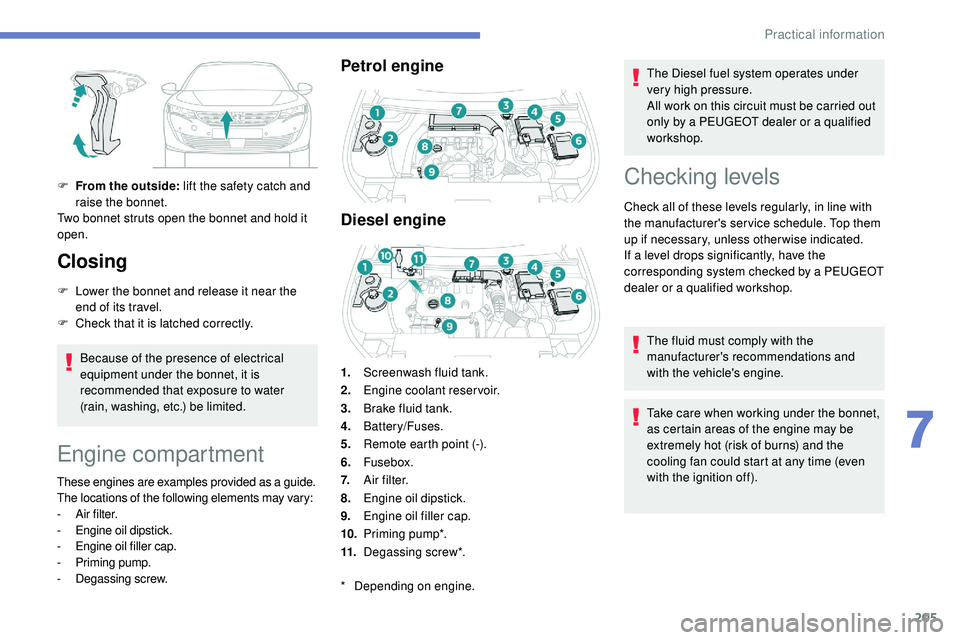
205
F From the outside: lift the safety catch and raise the bonnet.
Two bonnet struts open the bonnet and hold it
open.
Closing
F Lower the bonnet and release it near the end of its travel.
F
C
heck that it is latched correctly.
Because of the presence of electrical
equipment under the bonnet, it is
recommended that exposure to water
(rain, washing, etc.) be limited.
Engine compartment
These engines are examples provided as a guide.
The locations of the following elements may vary:
-
A
ir filter.
-
E
ngine oil dipstick.
-
E
ngine oil filler cap.
-
P
riming pump.
-
D
egassing screw.
Petrol engine
Diesel engine
1.Screenwash fluid tank.
2. Engine coolant reservoir.
3. Brake fluid tank.
4. Battery/Fuses.
5. Remote earth point (-).
6. Fusebox.
7. A i r f i l t e r.
8. Engine oil dipstick.
9. Engine oil filler cap.
10. Priming pump*.
11. Degassing screw*. The Diesel fuel system operates under
very high pressure.
All work on this circuit must be carried out
only by a PEUGEOT dealer or a qualified
workshop.
Checking levels
Check all of these levels regularly, in line with
the manufacturer's service schedule. Top them
up if necessary, unless other wise indicated.
If a level drops significantly, have the
corresponding system checked by a PEUGEOT
dealer or a qualified workshop.
The fluid must comply with the
manufacturer's recommendations and
with
the vehicle's engine.
Take care when working under the bonnet,
as certain areas of the engine may be
extremely hot (risk of burns) and the
cooling fan could start at any time (even
with the ignition off).
*
D
epending on engine.
7
Practical information
Page 208 of 320

206
Used products
Avoid prolonged contact of used oil or
fluids with the skin.
Most of these fluids are harmful to health
or indeed very corrosive.Do not discard used oil or fluids into
sewers or onto the ground.
Take used oil to a PEUGEOT dealer or a
qualified workshop and dispose of in the
containers reser ved for this purpose.
Engine oil level
The check is carried out either when
the ignition is switched on using the
oil level indicator in the instrument
panel for vehicles equipped with an
electric gauge, or using the dipstick.
To ensure that the reading is correct, your
vehicle must be parked on a level sur face
with the engine stopped for more than
30
minutes.
It is normal to top up the oil level between
two ser vices (or oil changes). PEUGEOT
recommends that you check the level, and top
up if necessary, every 3,000 miles (5,000 km).
Checking using the dipstick
The location of the dipstick is shown in the
corresponding underbonnet layout view.
F
T
ake the dipstick by its coloured grip and
pull it out completely.
F
W
ipe the end of the dipstick using a clean
non-fluffy cloth.
F
R
efit the dipstick and push fully down, then
pull it out again to make the visual check:
the correct level is between marks A and B .
A = MA X
B = MIN
If you find that the level is above the A mark or
below the B mark, do not star t the engine.
-
I
f the level is above the MAX mark (risk of
damage to the engine), contact a PEUGEOT
dealer or a qualified workshop.
-
I
f the level is below the MIN mark, you must
top up the engine oil.
Oil grade
Before topping up the oil or changing the oil,
check that the oil is the correct grade for your
engine and conforms to the manufacturer's
recommendations.
Topping up the engine oil level
The location of the oil filler cap is shown in the
corresponding underbonnet layout view.
F
U
nscrew the oil filler cap to access the filler
opening.
F
A
dd oil in small quantities, avoiding any
spills on engine components (risk of fire).
F
W
ait a few minutes before checking the
level again using the dipstick.
F
A
dd more oil if necessary.
F
A
fter checking the level, carefully refit the oil
filler cap and the dipstick in its tube.
After topping up the oil, the check when
switching on the ignition with the oil
level indicator in the instrument panel
is not
valid during the 30 minutes after
topping up.
Practical information
Page 226 of 320
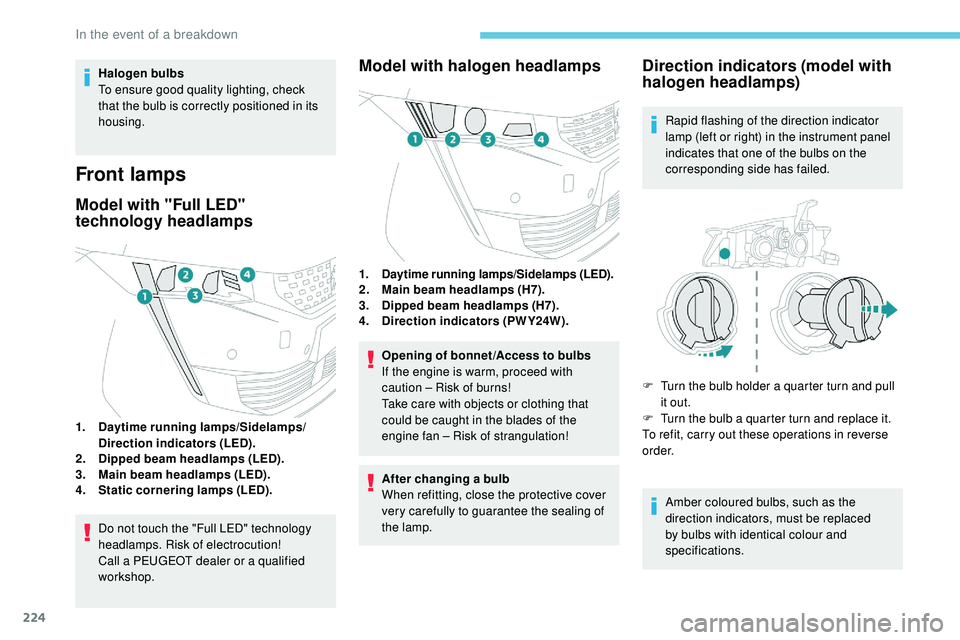
224
Halogen bulbs
To ensure good quality lighting, check
that the bulb is correctly positioned in its
housing.
Front lamps
Model with "Full LED"
technology headlamps
1.Daytime running lamps/Sidelamps/
Direction indicators (LED).
2. Dipped beam headlamps (LED).
3. Main beam headlamps (LED).
4. Static cornering lamps (LED).
Do not touch the "Full LED" technology
headlamps. Risk of electrocution!
Call a PEUGEOT dealer or a qualified
workshop.
Model with halogen headlamps
1.Daytime running lamps/Sidelamps (LED).2.Main beam headlamps (H7).
3. Dipped beam headlamps (H7).
4. Direction indicators (PWY24W).
Opening of bonnet /Access to bulbs
If the engine is warm, proceed with
caution – Risk of burns!
Take care with objects or clothing that
could be caught in the blades of the
engine fan – Risk of strangulation!
After changing a bulb
When refitting, close the protective cover
very carefully to guarantee the sealing of
the lamp.
Direction indicators (model with
halogen headlamps)
Rapid flashing of the direction indicator
lamp (left or right) in the instrument panel
indicates that one of the bulbs on the
corresponding side has failed.
F
T
urn the bulb holder a quarter turn and pull
it out.
F
T
urn the bulb a quarter turn and replace it.
To refit, carry out these operations in reverse
o r d e r.
Amber coloured bulbs, such as the
direction indicators, must be replaced
by bulbs with identical colour and
specifications.
In the event of a breakdown
Page 311 of 320
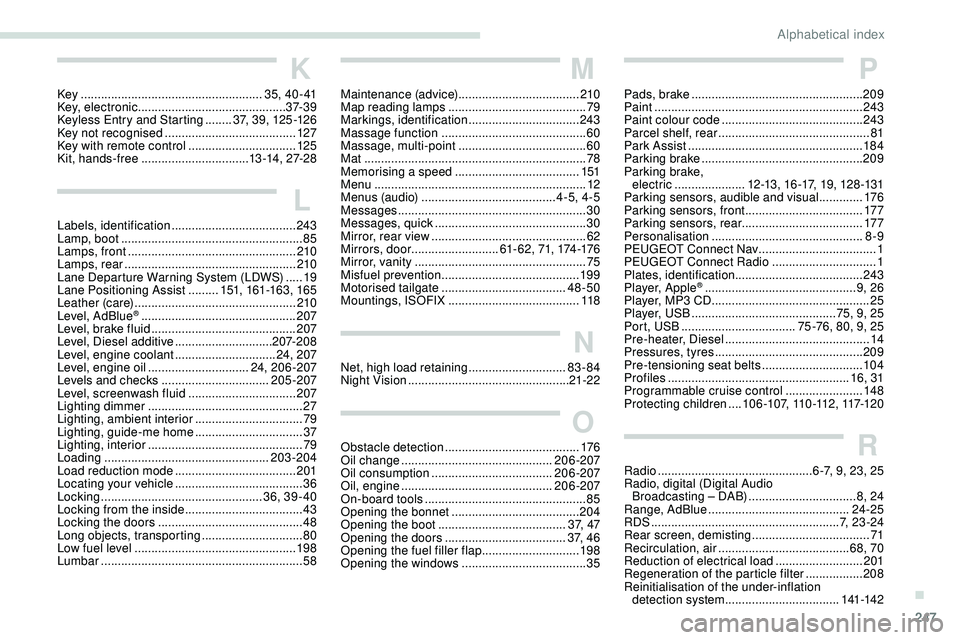
247
K
Key ...................................................... 3 5 , 4 0 - 41
Key, electronic ............................................37- 3 9
Keyless Entry and Starting
........3
7, 3 9, 125 -126
Key not recognised
....................................... 12
7
Key with remote control
................................12
5
Kit, hands-free
................................ 1
3 -14, 27-2 8
L
Labels, identification ..................................... 243
Lamp, boot ...................................................... 85
Lamps, front
.................................................. 210
Lamps, rear
................................................... 210
Lane Departure Warning System (LDWS)
.....19
Lane Positioning Assist
.........151, 161-163, 165
Leather (care)
................................................ 210
Level, AdBlue
® .............................................. 2 07
Level, brake fluid ........................................... 207
Level, Diesel additive
............................. 207-208
Level, engine coolant
.............................. 24, 207
Level, engine oil
.............................. 24, 206-207
Levels and checks
..............................
..205-207
Level, screenwash fluid
................................ 2
07
Lighting dimmer
.............................................. 27
Lighting, ambient interior
................................ 79
L
ighting, guide-me home
................................ 37
Lighting, interior
...............................
...............79
Loading
................................................. 203-204
Load reduction mode
.................................... 201
Locating your vehicle
...................................... 36
Locking
...............................
.................36, 39 - 40
Locking from the inside
................................... 43
Locking the doors
........................................... 48
L
ong objects, transporting
.............................. 80
Low fuel level
................................................ 19
8
Lumbar
............................................................ 58
M
Maintenance (advice) ....................................2 10
Map reading lamps ......................................... 79
M
arkings, identification
.................................243
Massage function
........................................... 60
Massage, multi-point
...................................... 60
Mat
.................................................................. 78
Memorising a speed
..................................... 1
51
Menu
............................................................... 12
Menus (audio)
........................................ 4-5, 4-5
Messages
........................................................ 30
Messages, quick
............................................. 3
0
Mirror, rear view
.............................................. 62
Mirrors, door .......................... 61- 6 2 , 71, 174 -176
Mirror, vanity
................................................... 75
Misfuel prevention
......................................... 19 9
Motorised tailgate
..................................... 48
-50
Mountings, ISOFIX
....................................... 11 8
N
Net, high load retaining .............................83-84
Night Vision ................................................ 21-22
O
Obstacle detection ........................................ 176
Oil change ............................................. 20
6-207
Oil consumption
.................................... 206-207
Oil, engine
............................................. 206-207
On-board tools
................................................ 85
Opening the bonnet
...................................... 204
Opening the boot
...................................... 3 7, 4 7
Opening the doors
.................................... 3 7, 4 6
Opening the fuel filler flap
.............................198
Opening the windows
..................................... 35
P
Pads, brake ................................................... 209
Paint .............................................................. 243
Paint colour code
.......................................... 243
Parcel shelf, rear
............................................. 81
Park Assist
...............................
.....................18 4
Parking brake
................................................ 209
Parking brake, electric
..................... 12-13 , 16 -17, 19, 128 -131
Parking sensors, audible and visual
.............176
Parking sensors, front
...................................17 7
Parking sensors, rear .................................... 17 7
Personalisation
............................................. 8-9
PEUGEOT Connect Nav
...................................1
PEUGEOT Connect Radio
...............................1
P
lates, identification ...................................... 243
Player, Apple
® ............................................. 9 , 26
Player, MP3 CD ............................... ................25
Player, USB
........................................... 75, 9, 25
Port, USB
.................................. 75 -76, 80, 9, 25
Pre-heater, Diesel
........................................... 14
Pressures, tyres
............................................ 209
Pre-tensioning seat belts
.............................. 104
Profiles
...................................................... 16, 31
Programmable cruise control
.......................148
Protecting children
....1 0 6 -1 0 7, 11 0 -112 , 117-12 0
R
Radio .............................................. 6 -7, 9, 23, 25
Radio, digital (Digital Audio Broadcasting – DAB)
................................8, 24
Range, AdBlue
.......................................... 24-25
RDS
................
........................................ 7, 2 3 - 2 4
Rear screen, demisting
...................................71
Recirculation, air
....................................... 68, 70
Reduction of electrical load
..........................201
Regeneration of the particle filter
.................208
Reinitialisation of the under-inflation detection system
.................................. 141-142
.
Alphabetical index